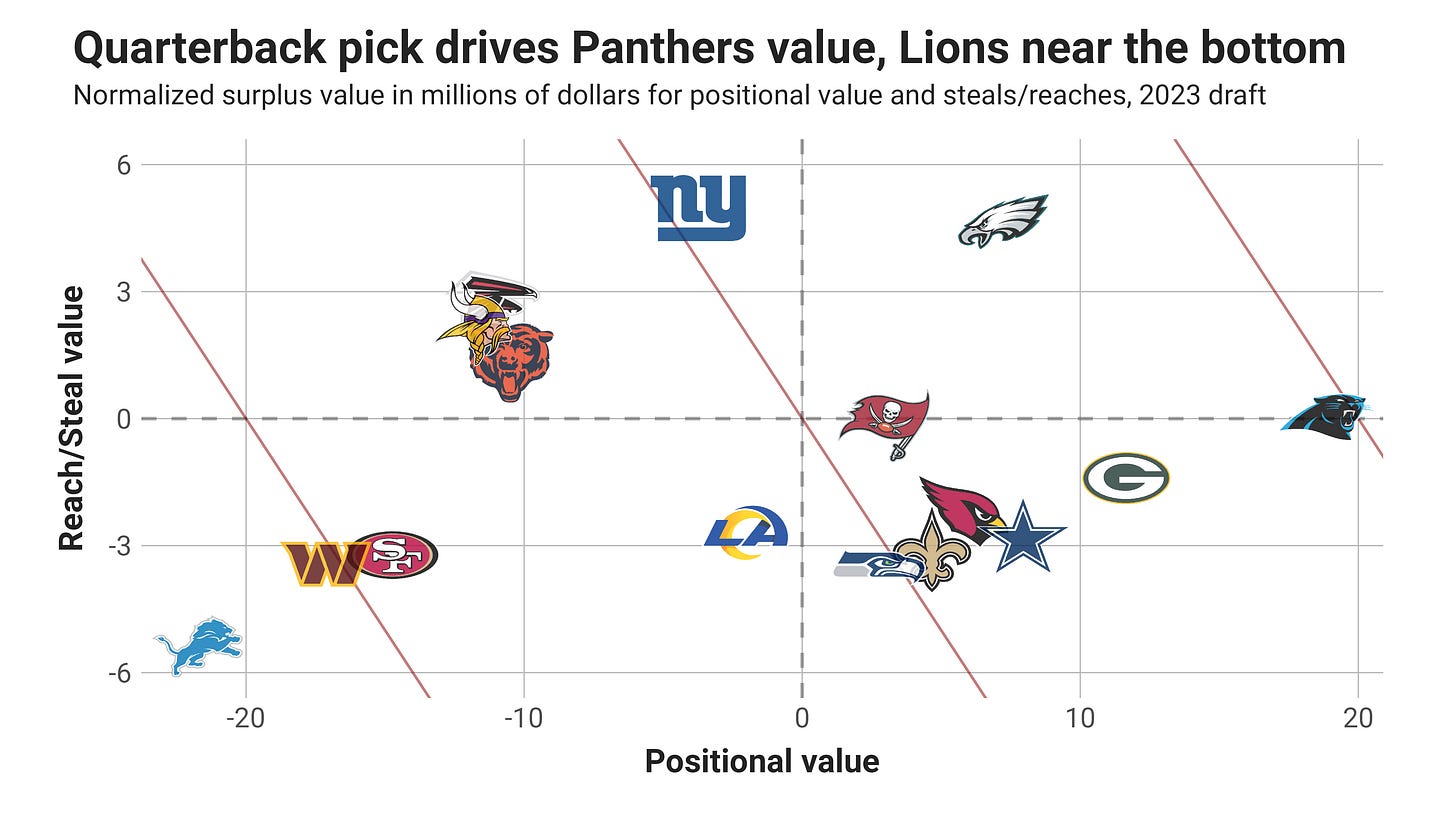NFC analytical draft grades
Quantifying trade, positional and selection value for the most accurate and predictive assessments of how well teams did in the NFL draft
Three days, seven rounds and 259 picks later, the culmination of months of planning and detail for 32 NFL franchises has come and gone. All that’s left now is to sort through the results. I recently discussed in detail why parsing the noise for signal in draft grading can be so difficult, mostly because the draft media industrial complex doesn’t focus on what’s most important and predictive.
Draft content is mostly about who will be the best players in the NFL, so that’s also what drives most draft grades. The problem is that all the research around the draft shows that giving kudos or demerits based on how teams drafted versus your expectation is a fool’s errand. There’s only a little correlation between a loss in value when teams reach for a player versus consensus, and nearly no correlation if they draft a player later that we think they’ll go before the draft. As I explained in my draft grading philosophy primer:
It isn’t that prospect evaluation doesn’t matter, it’s that NFL teams pour so many resources and expertise into the task that relative success and failure will be narrow, especially over a longer timeline. You shouldn’t take away from the data that no teams are really good at prospect evaluations. Instead it’s that all teams are really good, and likely much better than outside evaluators.
While we can’t rely too heavily on the specific prospects the team chose at there draft slots, there are larger macro forces that teams can leverage to, on average, better their draft outcomes. The two primary drivers of quantifiable draft value are:
Trade value gained/lost
Positional value gained/lost
There are extended bodies of research on the value teams can gain trading back in the NFL, and in this analysis I quantify that value through looking at the equivalent value in NFL salary of players similar to those drafted. Rookie contracts are set at artificially low amounts, so the the difference in player value over contract value is what the team gains with each draft selection, or surplus value. Different positions are valued much differently in NFL contract markets, so hitting on an All-Pro level running back in the draft gives less surplus value at a particular draft selection than landing an elite edge rusher. When teams are faced with the choice of wear to allocate their draft capital, especially in early rounds, accounting of positional value will skew the odds of success in their favor.
Looking at all the NFC teams in terms of value added ($M) in trades (average expected surplus of picks traded away versus those gained) and what I call selection value (a combination of positional value and a much smaller contribution from taking players after/before their consensus value), you can see that a couple big trades skews the results, and how powerful the impacts of those trades can be.
Over the four-year lives of rookie contracts, the Bears and Cardinals can expect to gain more than $50 million in value over salary from the players they draft with the picks acquired versus who they would have drafted if they hadn’t traded down. On the flip side, the Panthers lost as much as Bears gained on the transaction, though it could be mitigated, or even reversed, if Bryce Young ends up becoming an elite quarterback and a value well beyond his rookie contract. Trading up for quarterbacks is the one area where traditional calculations of trade value likely don’t encompass the true range of outcomes.
Digging further into the two components of selection value, we see that positional value has a bigger relative impact, more than three times the standard deviation of value gained by drafting players versus consensus rankings.
The reach/steal paradigm is going to be the primary driver of most draft grades you see from media analysts this week, yet’s it’s least impactful. Research shows that steals are much less likely to produce benefit than reaches cause harm, so you should be especially skeptical of draft grades that lean heavily into teams who drafted the most players far after their consensus expectations.
Let’s get to our analytical grading, going through each NFL division here. Again, if you want more details why I believe this is the best method for analyzing drafts in a predictive manner, check out my draft grading primer.
The eagles will be a popular selection for the winner of the NFL draft, and I agree they generally had a strong run of picks. They lost a little trade value in a couple trade-ups, but mostly offset them with two trade downs. Leveraging positional value is where Howie Roseman shined most, taking three Tier-1 positions in their first three picks, and only losing marginal value by waiting to take a lower-value safety in the third round.
I give credit to the Eagles for not reaching much in the draft, but I won’t be nearly as positive about selections like Jalen Carter, Nolan Smith and Kelee Ringo who went much later than expected. There’s likely a good reason so many teams passed on drafting those players considering that they play high-value positions.







